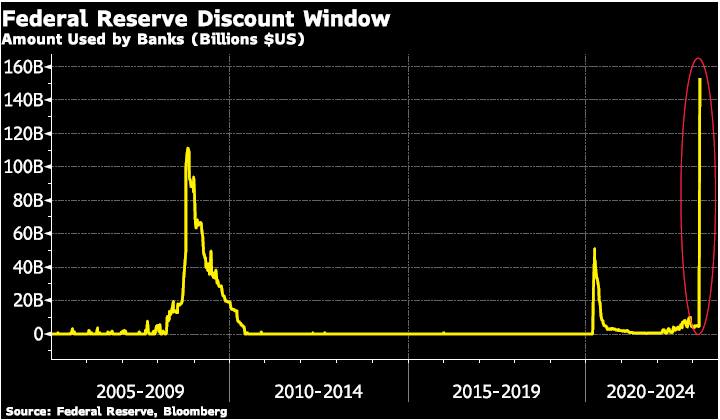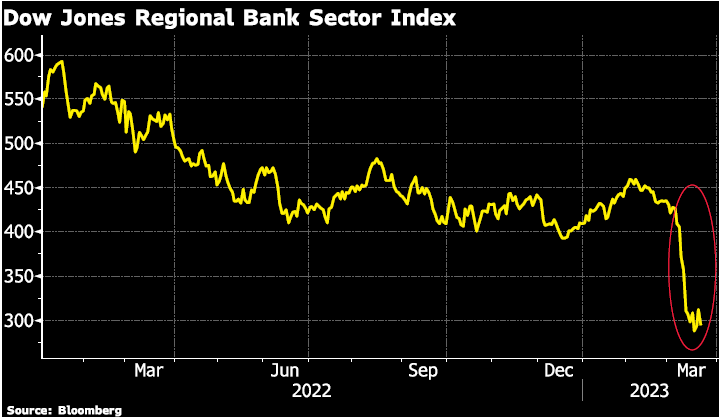
Central banks seem to be on a credibility drive at the moment. Last week it was the ECB, yesterday it was the Fed and today it was the Bank of England. All of them are on a mission to reiterate their approach of ‘because I said so!’ when it comes to raising rates. It seems that a snowballing banking crisis isn’t enough to spook them into thinking that maybe they have taken the wrong approach for a while now. Unsurprisingly, the more they bury their heads in the sand, the more savers and investors start to insure their portfolios with gold and silver bullion.
Do Central Banks really have everything under control?
Wednesday the Fed said…’don’t let the bank failures make you forget that we are invincible!
The message from the Fed this week literally was: yes, some banks collapsed after we raised rates but don’t worry …. we will create additional bailout mechanisms if more banks fail and meanwhile, we will continue raising rates too.
Despite problems in the banking sector, the Fed raised the fed funds rate by a further 25 basis points to a range of 4.75% to 5.00%. The Summary of Economic Projections released with the statement shows that, on average, members of the Committee think there will be one more rate hike to come this year, but are projecting the fed funds rate to decline to 4.3% by the end of next year, and down to 3.1% by the end of 2025.
The slightly higher fed funds rate projection contrasts with the change in statement language to The Committee anticipates that some additional policy firming may be appropriate… from the language used in the last meeting statement on February 1 that read The Committee anticipates that ongoing increases in the target range will be appropriate….
That .25% increase in interest rates comes just ten days after a coordinated effort by the U.S. Treasury, Federal Reserve, and FDIC (Federal Deposit Insurance Corporation). In a joint statement released on March 12 the three agencies went to great lengths to assure markets (and depositors in U.S. banks) by guaranteeing all deposits at the failed Silicon Valley Bank and at Signature Bank.
… We are taking decisive actions to protect the U.S. economy by strengthening public confidence in our banking system. This step will ensure that the U.S. banking system continues to perform its vital roles of protecting deposits and providing access to credit to households and businesses in a manner that promotes strong and sustainable economic growth.
Why I Think This Is The Next Financial Crisis
After receiving a recommendation from the boards of the FDIC and the Federal Reserve, and consulting with the President, Secretary Yellen approved actions enabling the FDIC to complete its resolution of Silicon Valley Bank, Santa Clara, California, in a manner that fully protects all depositors. Depositors will have access to all of their money starting Monday, March 13. No losses associated with the resolution of Silicon Valley Bank will be borne by the taxpayer.
We are also announcing a similar systemic risk exception for Signature Bank, New York, New York, which was closed today by its state chartering authority…
Then just two days ago the Federal Reserve engaged in another coordinated effort, this time with other central banks to ensure U.S. dollar liquidity. U.S. dollar liquidity often becomes strained in global markets because upwards of 60% of global transactions are in U.S. dollars.
What Does Credit Suisse Mean for Gold
It’s not just the Federal Reserve who refuses to stop raising rates despite banking messes caused by higher rates. Not paying attention to the strain in markets; the ECB raised rates by 50 basis points last week, despite global volatility and the obvious problems with Credit Suisse.
One could argue that the banking problems are so far only in isolated cases and if one believes Powell, there is not a larger contagion effect. So central banks should continue to raise rates to combat the much larger problem of inflation being too high. Although inflation is coming down it is still well above the 2% target.
But can the central bank really have it both ways? Isn’t it impossible to rescue the banking sector yet tighten monetary policy at the same time? Does the ‘implicit guarantee’ stop at just financial institutions, or what about the pension funds that invested in the banking sector that have lost money … Or the teacher’s unions … when does the rescue stop?
Readers know we have always warned central banking is a club of people helping themselves. Eventually, the pattern of central banks causing problems and saving only their own friends will risk becoming a class warfare style political issue.
Central banks don’t know the future!
Yet if they decide to save everyone all the time then inflation will go up instead of down. Exactly by stepping in to ensure all depositors and creating new facilities to lend to banks with ‘shaky balance sheets’ central banks are confirming an environment of complacency and risk taking.
Central banks later launch costly and long stretching ‘investigations’ into where regulation and supervision of the financial institution failed and write new rules to ‘make sure it never happens again’ … at least until the next time.
Central banks don’t know the future, and as our post on March 8 Is the US Economy Headed for Recession? discusses, central banks often use data that looks backward not forward. In a speech in May 2007, Federal Reserve chair Ben Bernanke said,
“We believe the effect of the troubles in the subprime sector on the broader housing market will likely be limited”.
Download Your Free Guide
He was epically mistaken. Does that statement sound familiar today? In the opening statement to the press conference, Powell assured markets that the isolated banking sector problems are contained and “Our banking system is sound and resilient, with strong capital and liquidity.”
The majority questions asked by the press at Powell’s press conference were focused on the problems in the banking sector and how the central bank intends to contain the fallout of the already failed banks and prevent others from failing.
The Dow Jones Regional Bank Sector Index shows that the equity prices of banks, in general, have stopped falling, but the index is still 30%+ down from where it was two weeks ago.
Problems in the banking sector do affect the overall economy. Powell told reporters that “We are looking at what’s happening among the banks and asking, is there going to be some tightening in credit conditions, in a way, that substitutes for rate hikes.”
Both president of the ECB, Lagarde, and Fed Chair Powell have said that they think further ‘monetary tightening will probably be needed’ but do not know how much or to what extent and where the next financial fragilities will become a crisis of confidence.
The decline in US Treasury yields, and of course the rise in gold and silver prices tell us that markets in general do not think that central banks have contained the fallout of the rapid rise in rates as much as they think they have.
Watch our market update with GoldCore CEO Stephen Flood where he discusses what happened last week with Credit Suisse and why it means that the ‘next’ financial crisis is here.
Buy Gold Coins

GOLD PRICES (USD, GBP & EUR – AM/ PM LBMA Fix)
22-03-2023 1941.85 1949.35 1580.67 1592.42 1800.87 1806.27
21-03-2023 1965.95 1952.50 1604.80 1598.12 1829.51 1811.92
20-03-2023 1981.95 1969.35 1624.41 1607.38 1853.92 1836.42
17-03-2023 1930.90 1962.10 1591.64 1614.81 1815.43 1845.16
16-03-2023 1919.40 1922.75 1593.87 1591.27 1810.38 1814.50
15-03-2023 1906.00 1923.40 1574.74 1593.73 1787.45 1823.38
14-03-2023 1901.45 1907.55 1563.75 1568.77 1774.81 1779.55
13-03-2023 1882.10 1911.30 1561.39 1572.62 1764.47 1782.86
10-03-2023 1834.95 1861.25 1530.35 1539.44 1731.09 1743.62
09-03-2023 1817.50 1831.40 1530.52 1536.73 1721.35 1731.77
Buy gold coins and bars and store them in the safest vaults in Switzerland, London or Singapore with GoldCore.
Learn why Switzerland remains a safe-haven jurisdiction for owning precious metals. Access Our Most Popular Guide, the Essential Guide to Storing Gold in Switzerland here
Receive Our Award Winning Market Updates In Your Inbox – Sign Up Here











